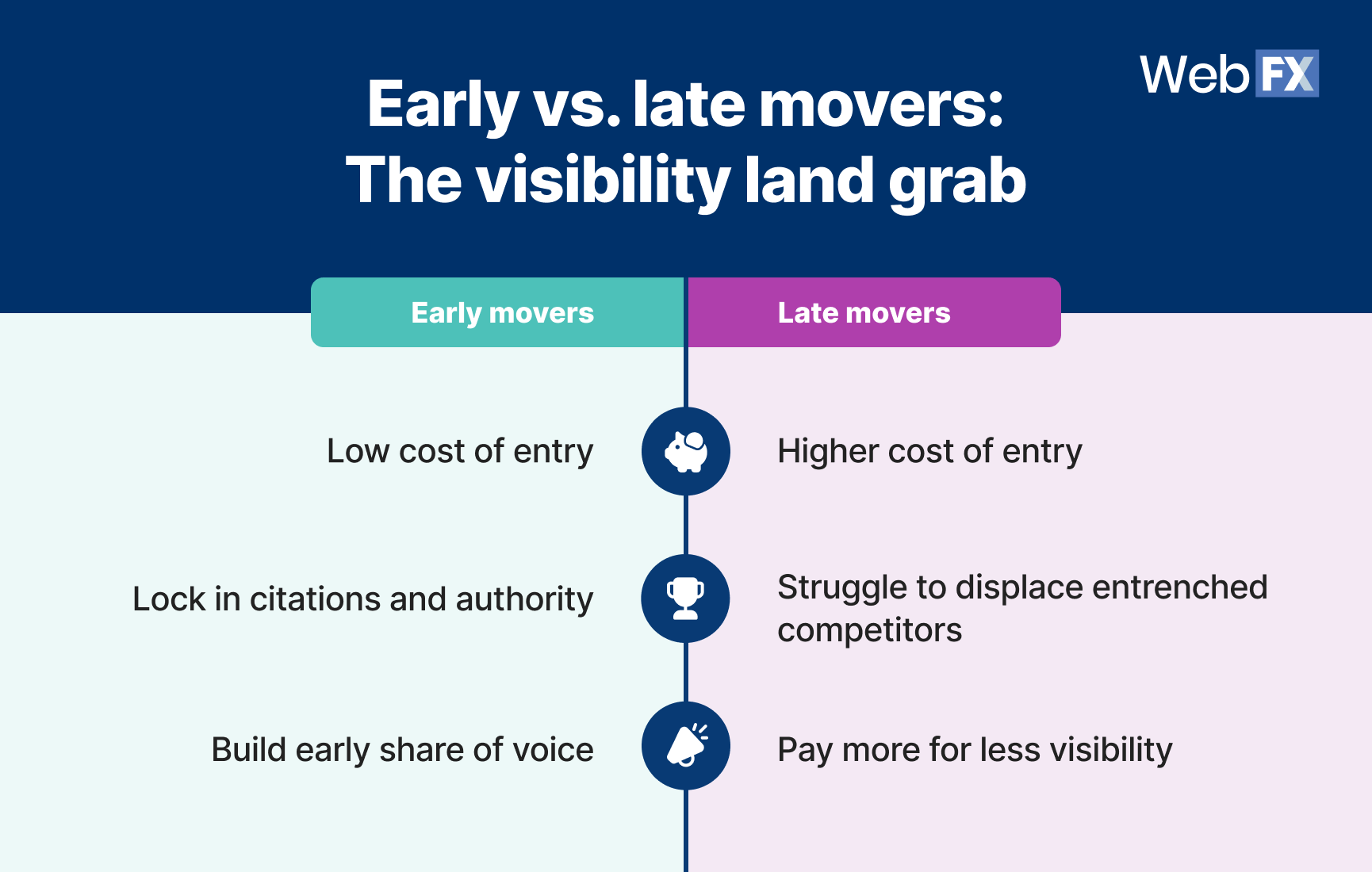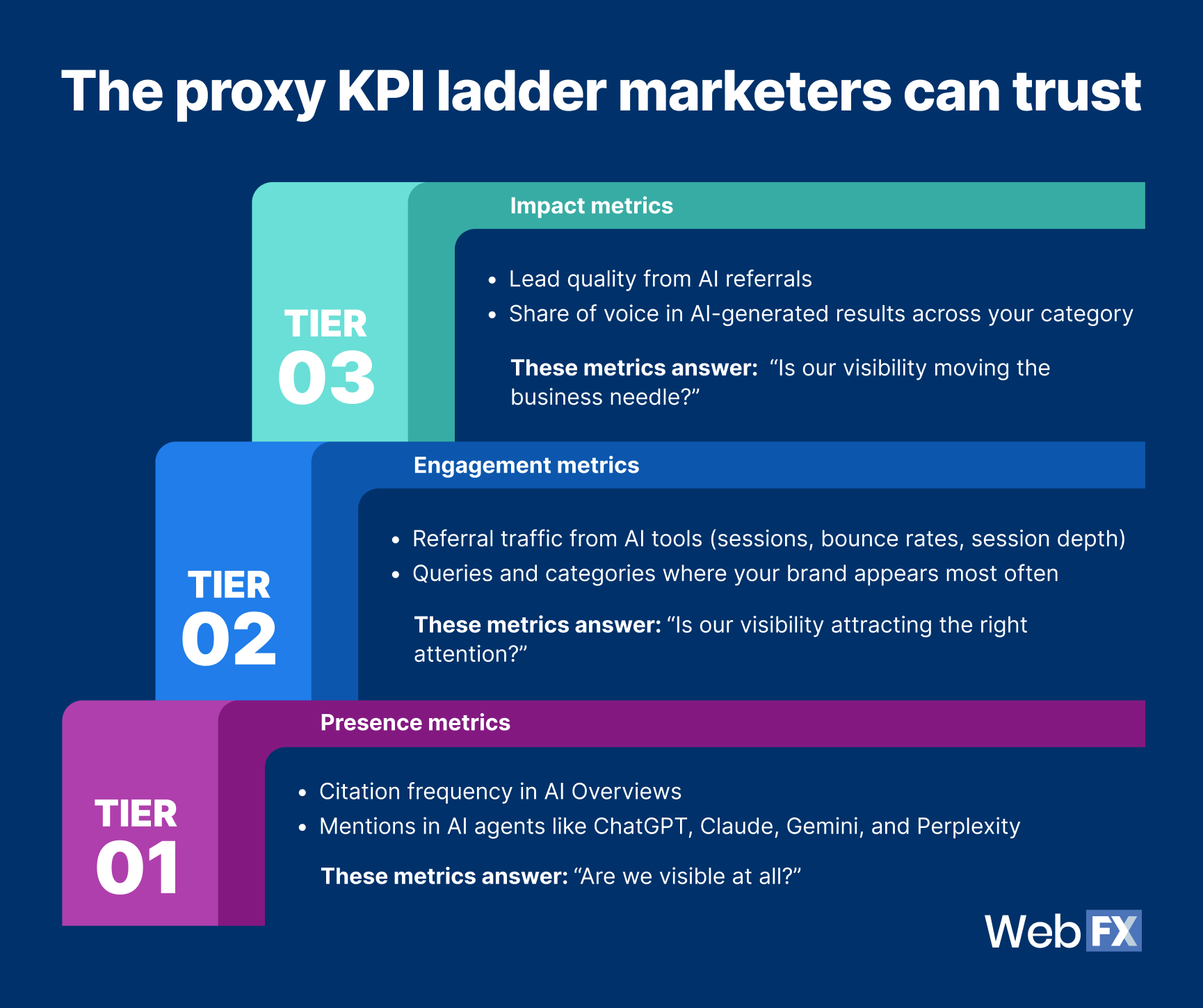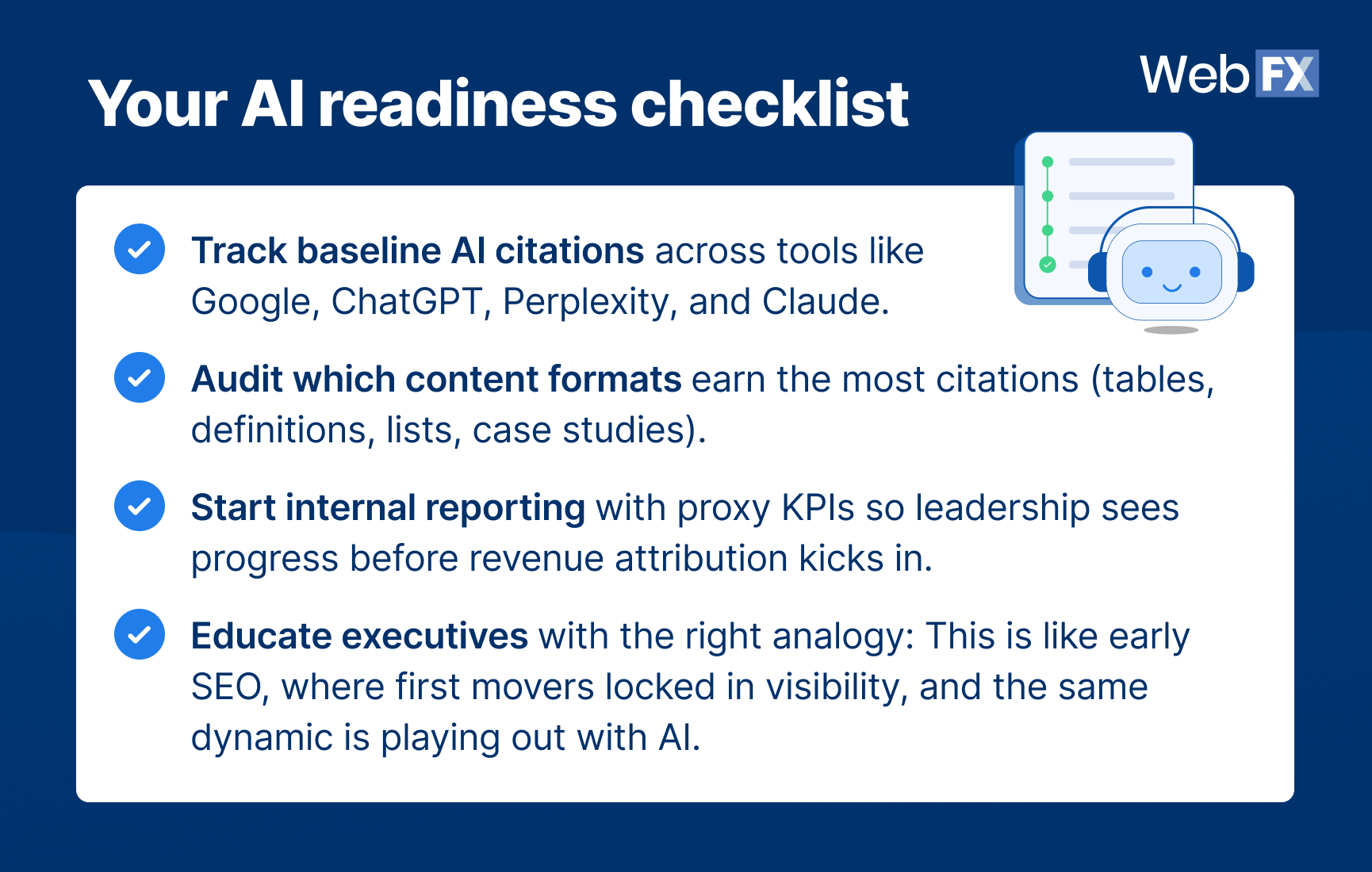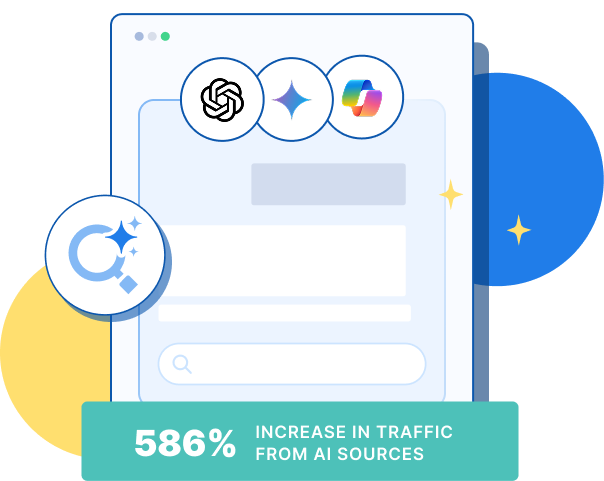-
 Published: Sep 22, 2025
Published: Sep 22, 2025
-
 8 min. read
8 min. read
-
Summarize in ChatGPT
-
 Albert Dandy Velasquez
Albert Dandy Velasquez Content Specialist
Content Specialist
- Albert Dandy Velasquez blends SEO strategy with compelling storytelling to help businesses boost their visibility and revenue online. With a B.A. in English and certifications from HubSpot, Semrush, and Google Analytics, he has written and optimized hundreds of articles on organic SEO, content strategy, and user experience. He regularly contributes to the WebFX blog and SEO.com, creating content that helps readers turn marketing goals into measurable results. When he’s off the clock, he’s usually exploring new neighborhoods on two wheels, filming travel content, or chasing golden hour with a coffee in hand.
Table of Contents
- The AI Visibility Paradox explained
- Why waiting for ROI is a losing strategy
- The proxy KPI ladder marketers can trust
- Tier 1: Presence metrics
- Tier 2: Engagement metrics
- Tier 3: Impact metrics
- Bonus metric: AI impression share
- How to frame proxy KPIs for leadership
- Your 2026 AI readiness checklist
- Secure AI visibility early. Prove ROI sooner.
- What are the three tiers of proxy KPIs for AI visibility? Tier 1 tracks presence metrics (citation frequency and mentions in AI agents), Tier 2 measures engagement (referral traffic and query categories), and Tier 3 evaluates impact (lead quality and share of voice in AI-generated results).
- What is the AI Visibility Paradox? The AI Visibility Paradox occurs when marketers need to invest in AI optimization to appear in AI Overviews and chatbot answers, but executives won’t approve budgets without clear ROI — creating a catch-22 where teams can’t prove value without first investing in visibility.
- Why should marketers track proxy KPIs instead of waiting for direct ROI? Proxy KPIs like citation frequency, referral traffic quality, and share of voice provide interim signals that demonstrate progress and protect budgets while revenue attribution from AI channels matures, preventing teams from falling behind competitors who invest early.
- How can marketers frame proxy KPIs for executive buy-in? Present AI visibility as a then → now → next narrative showing baseline metrics, current progress with proxy KPIs, and future revenue potential — positioning it as early-stage R&D that lays groundwork for measurable growth rather than vanity metrics.
- What risks do late movers face in AI visibility? Brands that wait for perfect attribution will find competitors have already claimed prime positions in AI Overviews and agent answers, making it significantly more difficult and expensive to displace established authorities and capture market share in machine-first search ecosystems.
Marketers chasing AI visibility quickly run into a wall: traditional ROI metrics don’t capture the early signals of success. That’s where proxy KPIs come in. These are measurable indicators—like citation frequency, referral quality, and impression share—that reveal how your content and AI initiatives are gaining traction, even before they generate revenue.
By focusing on these early-stage signals, teams can demonstrate progress, make data-informed adjustments, and build the case for further investment in AI-driven marketing. Let’s get down to brass tacks!
- The AI Visibility Paradox explained
- Why waiting for AI ROI is a losing strategy
- The proxy KPI ladder marketers can trust
- How to frame proxy KPIs for leadership
- Your 2026 AI readiness checklist
The AI Visibility Paradox explained
25.8% of 2.37 million US queries now trigger an AI Overview, yet leadership still demands ROI that AI referrals can’t precisely prove.
The AI Visibility Paradox boils down to this: AI visibility feels less tangible than channels we know. With traditional SEO, you’ve got keyword rankings and organic traffic. With paid search, you’ve got clicks and conversions. But when it comes to AI visibility, the signals get slippery. You might get cited in an AI Overview, name-dropped in a chatbot answer, or even a referral click, but rarely does that trail connect cleanly back to pipeline.
Some things are trackable. You can see referral traffic from AI tools like ChatGPT or Perplexity inside Google Analytics. That’s measurable. But once you move into Google’s AI Overviews or large language model (LLM) answers, the wires get fuzzy. Citations may shape buyer behavior without ever showing up as a lead in your CRM.
It’s not the first time marketers have been here. Look back to the early social media days. Likes, followers, and impressions were written off as mere vanity metrics. But the brands that paid attention, tracked the signals, and invested before attribution caught up are the ones that ended up owning reach and share of voice. AI visibility is playing out the same way.
And the numbers show just how fast it’s moving. In our study of 2.3 million US queries, one in four searches now surface an AI Overview. For long-tail informational searches, that rate jumps over 50%. In healthcare, it’s 51% and climbing. Yet surveys say most marketing leaders remain unconvinced there’s ROI. That skepticism is exactly why proxy KPIs matter. They bridge today’s fuzzy signals with tomorrow’s measurable revenue.
Why waiting for AI ROI is a losing strategy
The cost of sitting out AI visibility:
- Lost time: Competitors entrench in AI Overviews before you do.
- Higher costs: Playing catch-up later is more expensive and less effective.
- Budget cuts: Without proxy KPIs, CFOs cut funding before ROI shows up.
The biggest mistake marketers can make with AI visibility is sitting on the sidelines until revenue attribution is crystal clear. By the time the AI ROI trail is clean enough to satisfy the boardroom, competitors will already have locked in citations and authority. Displacing them later is not only more difficult, but also far more expensive.
Think of it as a visibility land grab. Early movers are staking claims in AI Overviews and generative AI answers, building the digital equivalent of shelf space. Once that territory is taken, latecomers are left fighting for scraps or paying a premium to break in.
Early vs. late movers: The visibility land grab

🔽 Table overview:
Early movers
Late movers
Low cost of entry
Higher cost of entry
Lock in citations and authority
Struggle to displace entrenched competitors
Build early share of voice
Pay more for less visibility
There’s also a leadership dimension to the risk. CFOs don’t keep funding projects without metrics. If AI visibility reporting boils down to “trust us, revenue will come,” budgets get cut long before the payoff arrives. Proxy KPIs give you the runway to prove traction, protect budget, and keep investment flowing while revenue signals mature.
The proxy KPI ladder marketers can trust
To prove progress before revenue attribution catches up, marketers need a staged framework: A proxy KPI ladder that moves from simple presence to measurable impact. Each tier offers signals you can report today to protect budget and build momentum.

Tier 1: Presence metrics
- Citation frequency in AI Overviews
- Mentions in AI agents like ChatGPT, Claude, Gemini, and Perplexity
These metrics answer: “Are we visible at all?” They show whether your brand is even on the radar of AI systems, the foundation for long-term visibility.
How to track: Monitor AI Overview citations with tools like Semrush Position Tracking or Ahrefs SERP features, and run manual prompt checks in agents like ChatGPT, Gemini, or Perplexity to spot mentions.
Tier 2: Engagement metrics
- Referral traffic from AI tools (sessions, bounce rates, session depth)
- Queries and categories where your brand appears most often
These metrics answer: “Is our visibility attracting the right attention?” Tracking engagement from AI referrals helps confirm whether the traffic you earn is relevant and aligned with your ideal customer profile (ICP).
How to track: Create a “Generative AI” custom channel group in Google Analytics 4 (GA4) to measure referral traffic, and use keyword tools to identify which queries and categories surface your brand.
Tier 3: Impact metrics
- Lead quality from AI referrals
- Share of voice in AI-generated results across your category
These metrics answer: “Is our visibility moving the business needle?” While attribution won’t be perfect yet, these signals tie AI visibility to pipeline indicators that leadership can recognize.
How to track: Use UTM parameters and source tagging to capture referral sessions from AI tools in GA4 or your CRM, and benchmark share of voice using Semrush, Ahrefs, or specialized AI visibility tools.
Bonus metric: AI impression share
Marketers may also want to start thinking about AI impression share: The percentage of relevant queries where their brand is cited or surfaced in AI-generated answers. Much like impression share in Google Ads, it isn’t a widely adopted KPI yet, but it’s a directional signal of growing authority in a machine-first search ecosystem.
How to frame proxy KPIs for leadership
Tracking proxy KPIs is only half the battle. The bigger challenge is framing them in a way that resonates with leadership. Executives don’t want a laundry list of metrics. They want a story that shows progress today and payoff tomorrow.

One effective approach is to use a then → now → next narrative. For example:🔽 Framework overview:
This framing makes proxy KPIs feel less like vanity metrics and more like milestones in a larger journey. It shows leadership where you’ve been, where you are, and where the ROI will eventually come from.
It also helps to position AI visibility as early-stage research and development (R&D). Just as companies invest in innovation before it pays off, proxy KPIs prove that your team is laying the groundwork for future growth. By reframing metrics like citation frequency and referral quality as leading indicators, you protect budget and buy-in until revenue catches up.
Your 2026 AI readiness checklist
Marketers can’t afford to wait until AI attribution is perfect. The brands that win will be the ones building authority now. Use this checklist to get started:

🔽 Checklist overview:
This checklist gives you a practical starting point: Measure where you are today, track progress, and set expectations with leadership that AI visibility is a long-term play.
Secure AI visibility early. Prove ROI sooner.
AI visibility isn’t a side project. It’s the next battleground for digital marketers. Waiting for perfect attribution means showing up late, after competitors have already claimed prime spots in AI Overviews and agent answers.
Marketers who act now, track proxy KPIs, and build authority early will be the first to prove ROI later. The ones who wait? They’ll be paying more for less visibility.
At WebFX, we don’t wait for the future of search. We engineer it. With 25+ years of digital expertise, our generative engine optimization (GEO) services are built to put your brand where AI looks first.
AI won’t wait, and neither should you. Contact us online or call 888-601-5359 to claim your spot early with WebFX’s industry-leading GEO services.
-
 Albert Dandy Velasquez blends SEO strategy with compelling storytelling to help businesses boost their visibility and revenue online. With a B.A. in English and certifications from HubSpot, Semrush, and Google Analytics, he has written and optimized hundreds of articles on organic SEO, content strategy, and user experience. He regularly contributes to the WebFX blog and SEO.com, creating content that helps readers turn marketing goals into measurable results. When he’s off the clock, he’s usually exploring new neighborhoods on two wheels, filming travel content, or chasing golden hour with a coffee in hand.
Albert Dandy Velasquez blends SEO strategy with compelling storytelling to help businesses boost their visibility and revenue online. With a B.A. in English and certifications from HubSpot, Semrush, and Google Analytics, he has written and optimized hundreds of articles on organic SEO, content strategy, and user experience. He regularly contributes to the WebFX blog and SEO.com, creating content that helps readers turn marketing goals into measurable results. When he’s off the clock, he’s usually exploring new neighborhoods on two wheels, filming travel content, or chasing golden hour with a coffee in hand. -

WebFX is a full-service marketing agency with 1,100+ client reviews and a 4.9-star rating on Clutch! Find out how our expert team and revenue-accelerating tech can drive results for you! Learn more
Try our free Marketing Calculator
Craft a tailored online marketing strategy! Utilize our free Internet marketing calculator for a custom plan based on your location, reach, timeframe, and budget.
Plan Your Marketing Budget
Table of Contents
- The AI Visibility Paradox explained
- Why waiting for ROI is a losing strategy
- The proxy KPI ladder marketers can trust
- Tier 1: Presence metrics
- Tier 2: Engagement metrics
- Tier 3: Impact metrics
- Bonus metric: AI impression share
- How to frame proxy KPIs for leadership
- Your 2026 AI readiness checklist
- Secure AI visibility early. Prove ROI sooner.

See AI Marketing in Action
Explore how WebFX helped a regional brand get discovered in AI search experiences — proving what’s possible with today’s AI-driven marketing!

Proven Marketing Strategies
Try our free Marketing Calculator
Craft a tailored online marketing strategy! Utilize our free Internet marketing calculator for a custom plan based on your location, reach, timeframe, and budget.
Plan Your Marketing Budget




